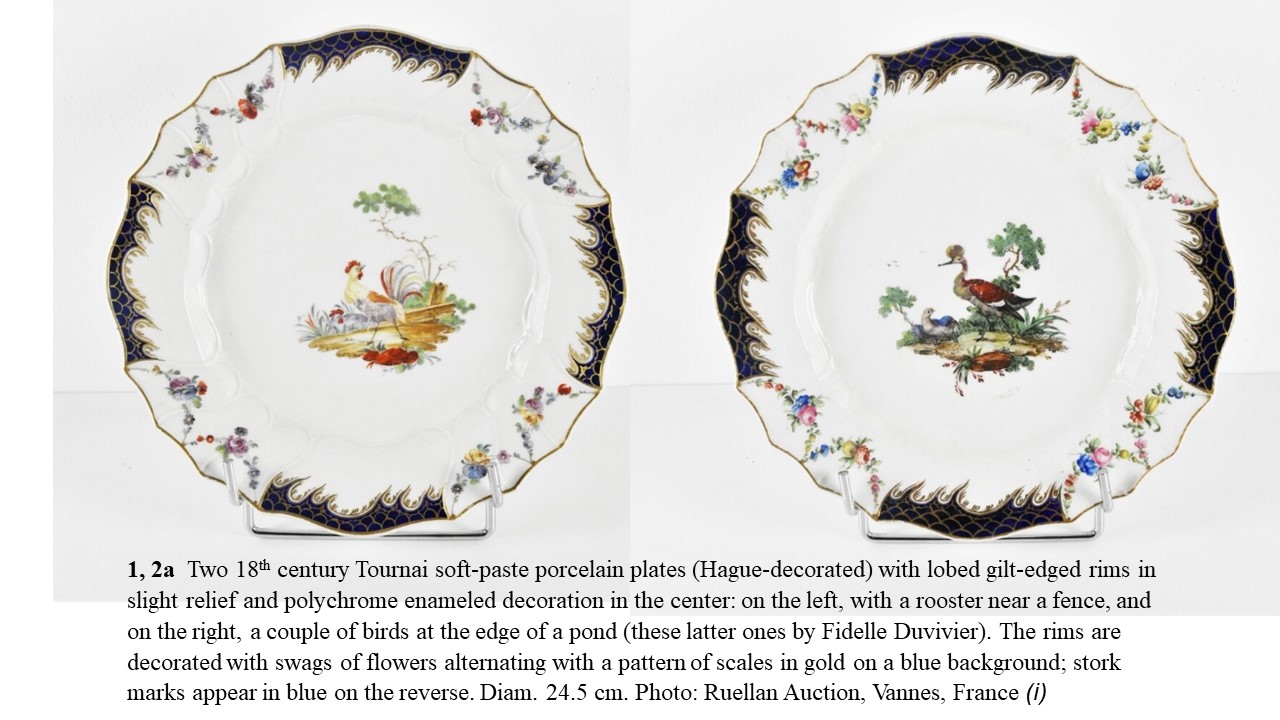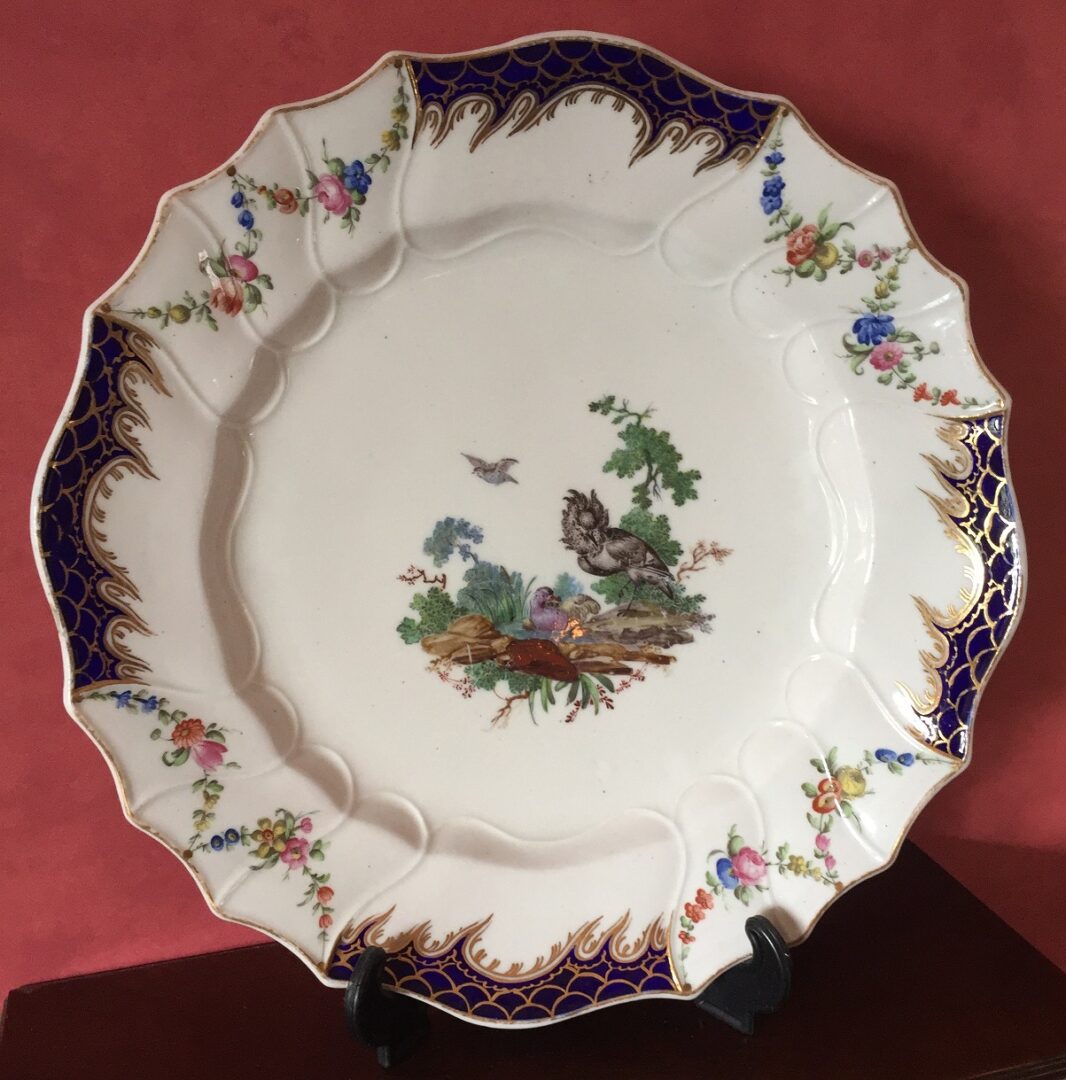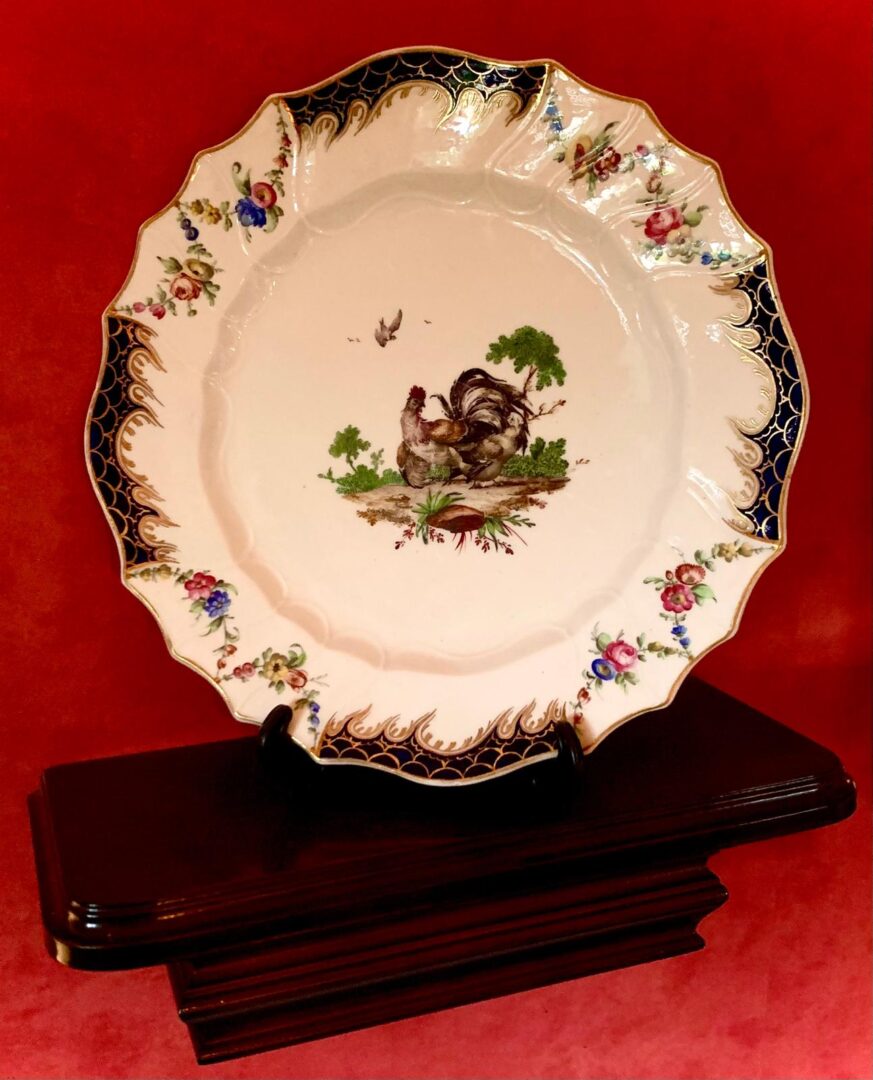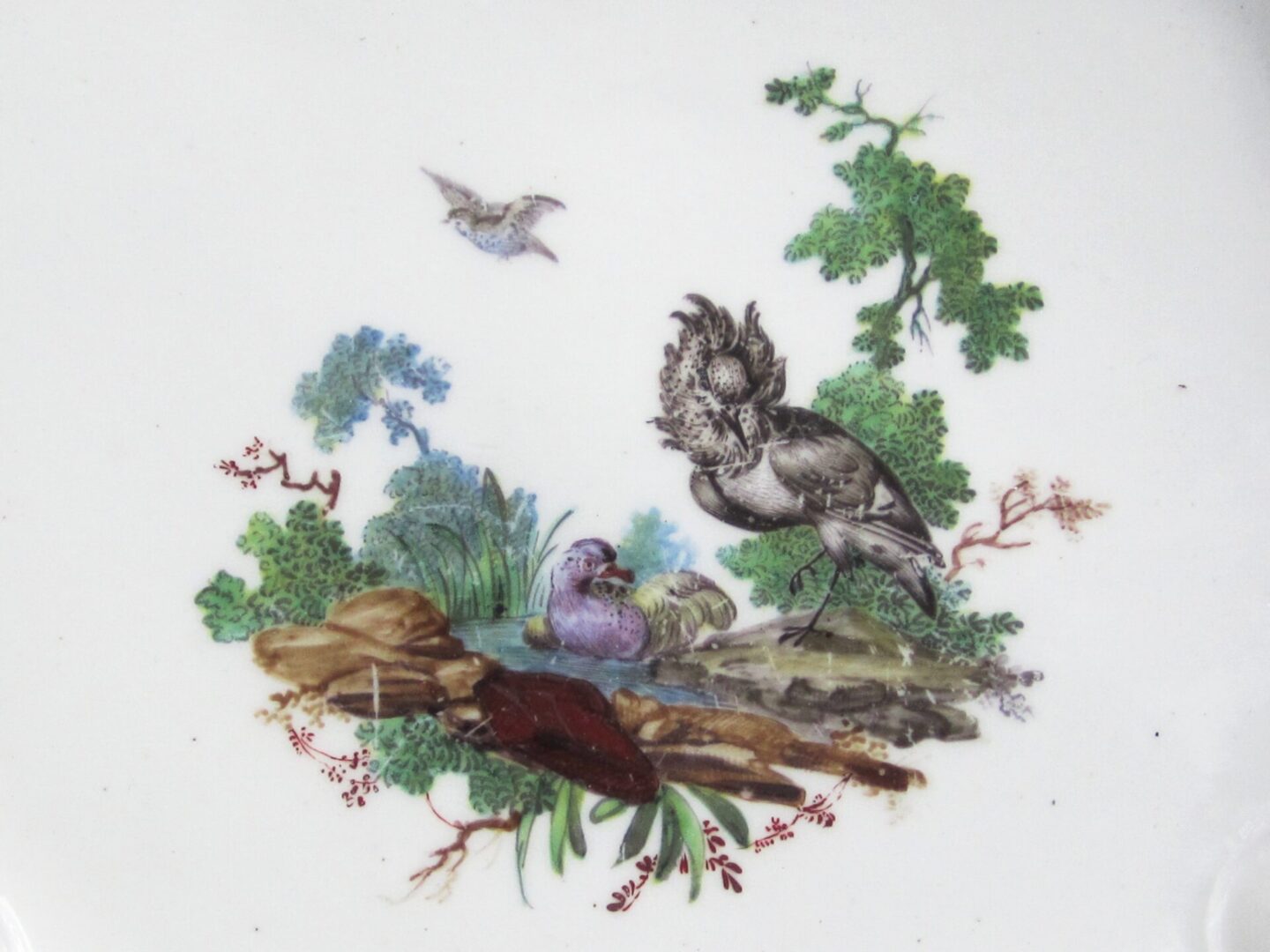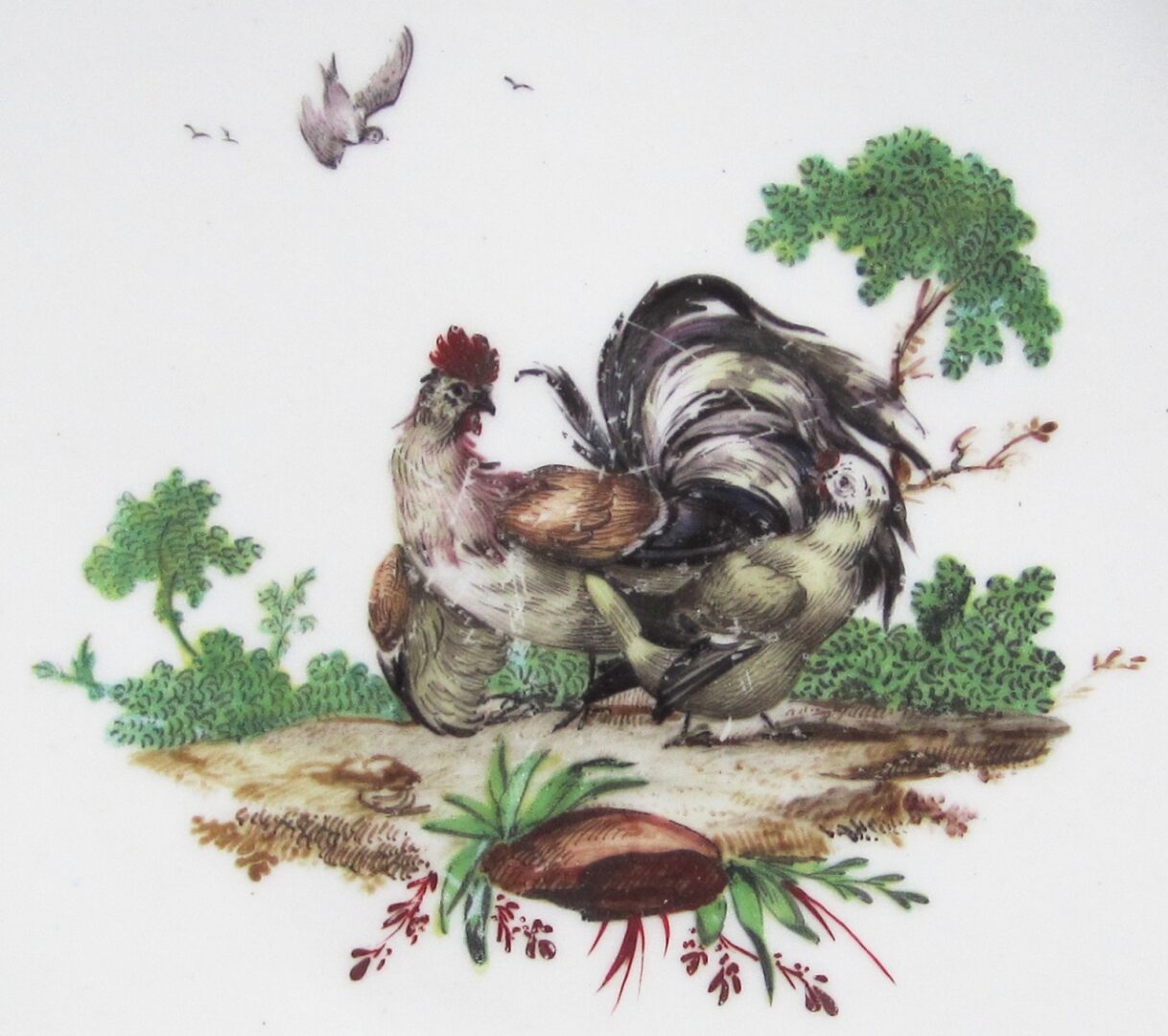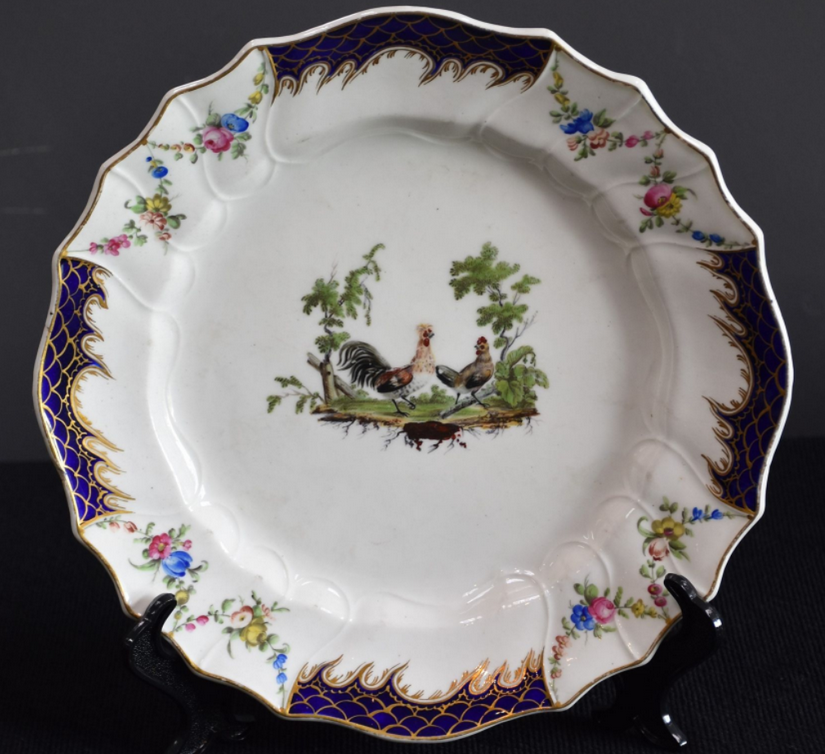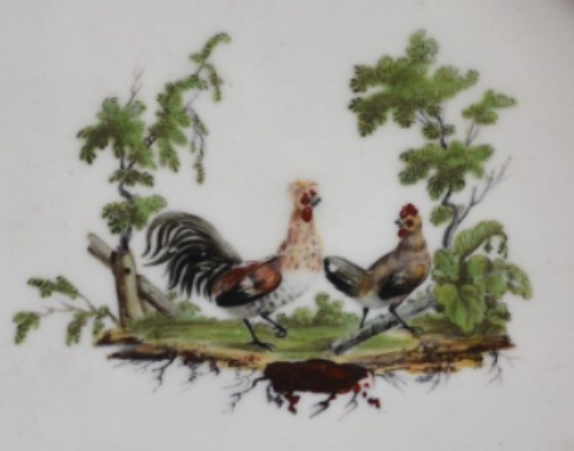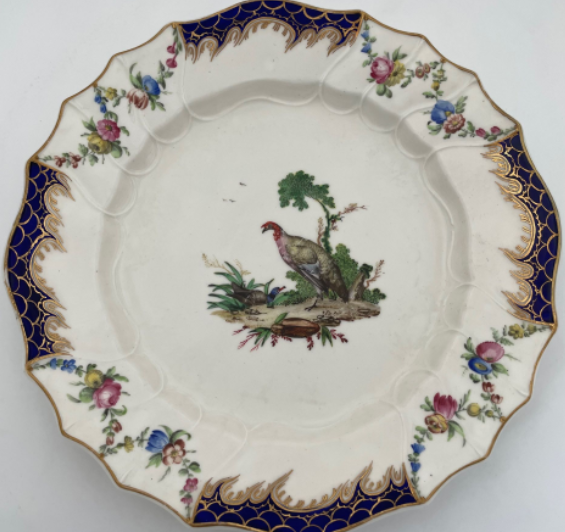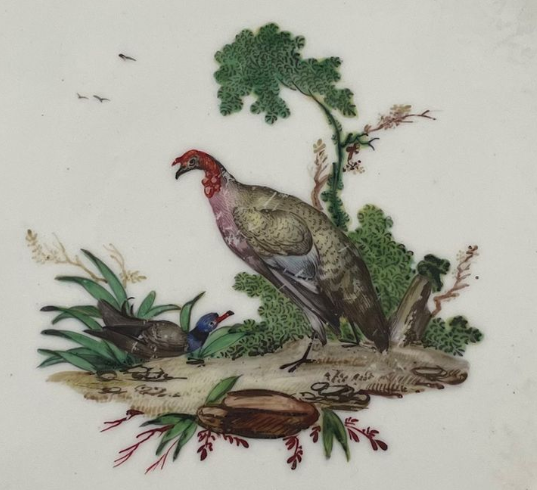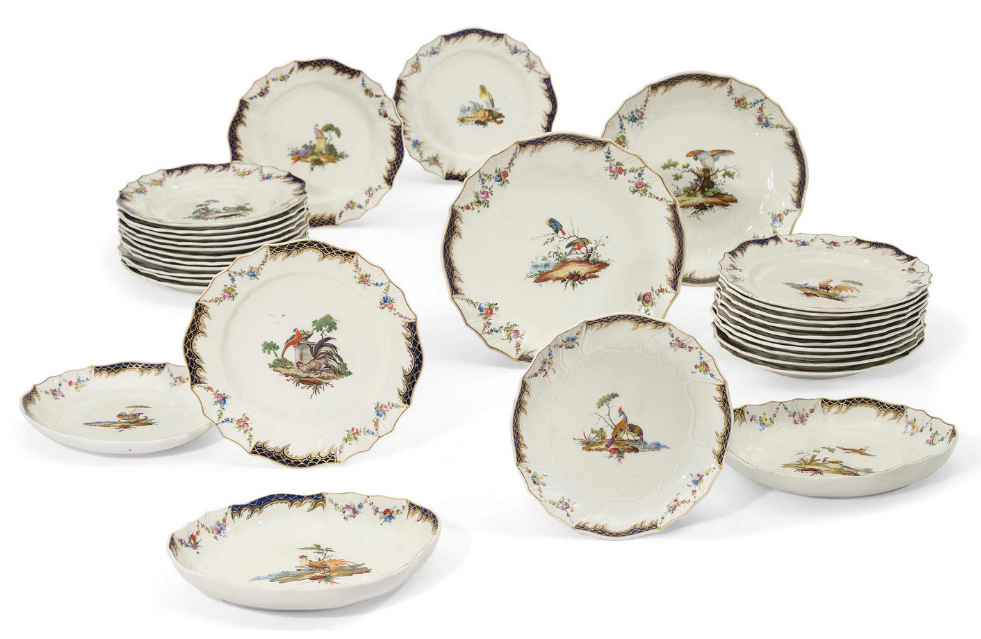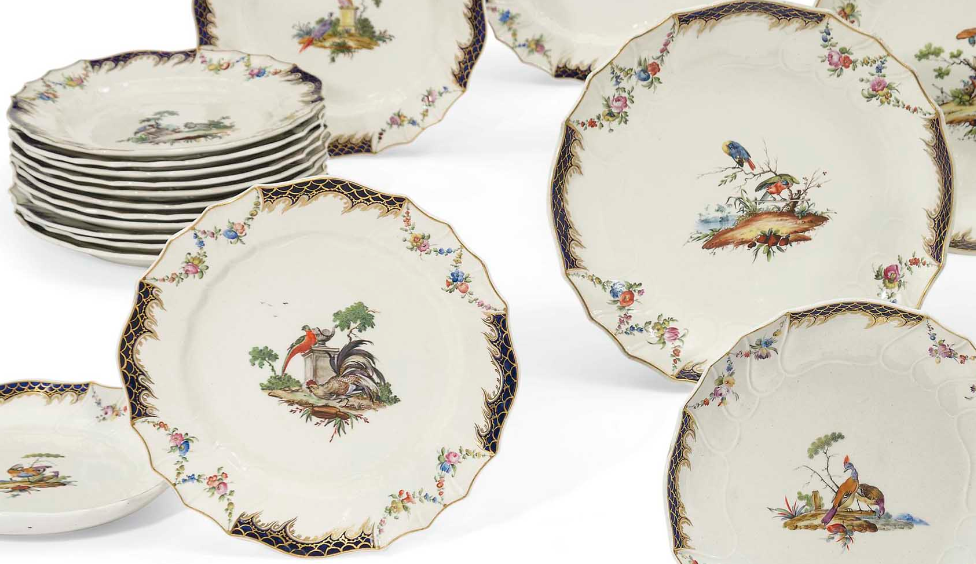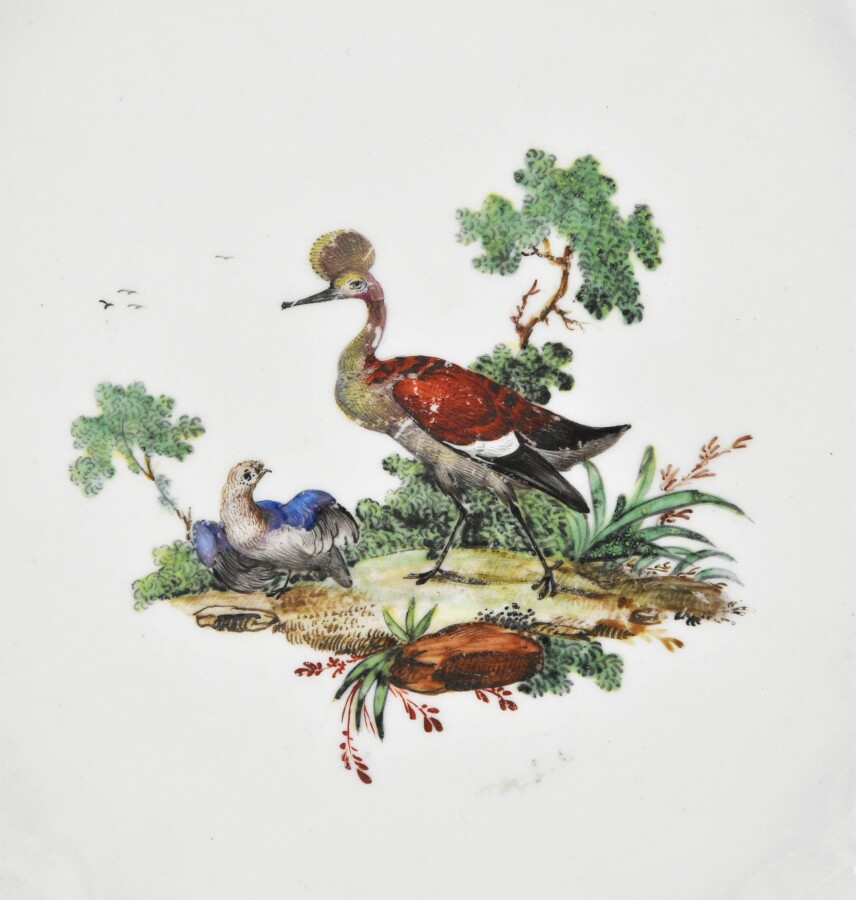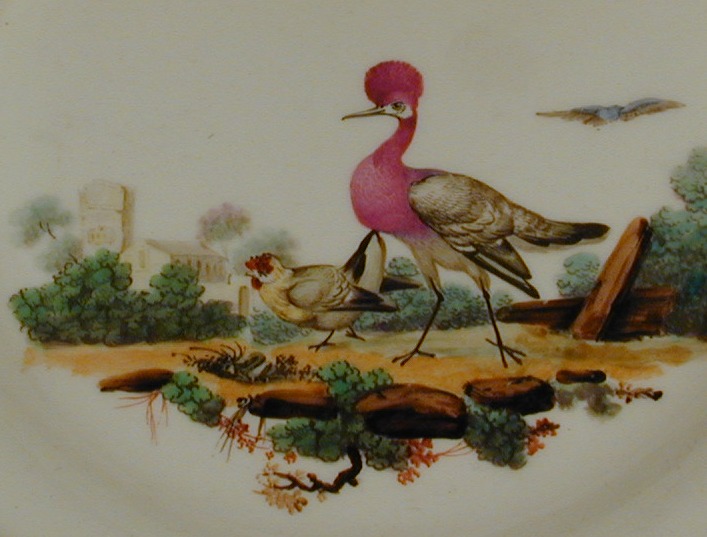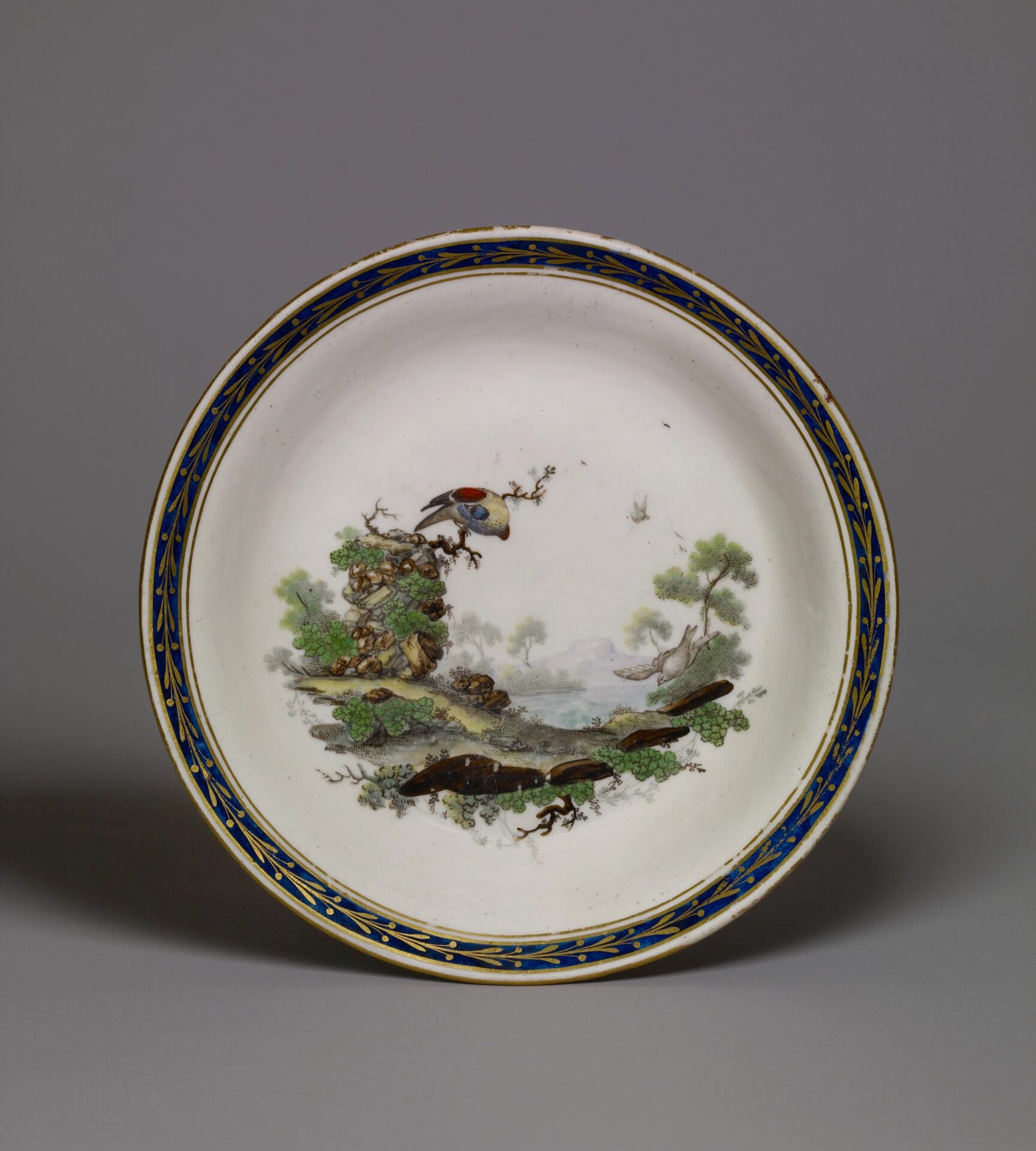In 1776 the German-born Anton Lyncker (1718-81) had founded a business in The Hague, claiming to make and decorate his own porcelain. But in truth he only dealt in foreign porcelains that were decorated in his workshop.(ii) He imported mainly blank hard-paste porcelain from Ansbach and blank or partially decorated soft-paste porcelain from Tournai. In most cases the Tournai pieces were delivered with some cobalt blue coloring on the rims or elsewhere, already applied under the glaze. This was a high-firing color and it meant that his painters could add further polychrome decoration and gilding (plus a stork mark on the base), all of which could be fired at lower temperatures in a decorating kiln.(iii)
Around 1775 the Tournai manufactory was making changes to the shapes and style of its tablewares. The rocaille forms were being phased out and replaced with simpler shapes and lighter decorations. For this reason the factory was quite willing to sell any quantity of blank or partially decorated porcelain to the Lynckers’ business between 1776 and 1790.
.
After Anton Lyncker’s death in 1781, his widow and son were managing the decorating business and attempting to reduce their inventory. They appear to have hired on additional temporary decorators to turn their stock of unsold porcelain into marketable wares.
Duvivier decorated a number of Ansbach tureens, presentoirs, coffee and tea service pieces, as well as ewers and basins with putti or landscape scenes, and these were the examples I first discovered in literature and in the reserve collection of the Gemeentemuseum (now the Kunstmuseum) in The Hague. Some of these examples were published in 2016 in my book, In the Footsteps of Fidelle Duvivier and other articles. Since then further examples have been discovered online in Dutch auctions.
I had been expecting to find Duvivier’s decoration on Tournai porcelain as well. Yet as of 2016 only one example, a covered chocolate cup with saucer, had turned up in the Rijksmuseum’s collection (Footsteps, p. 60, 69a, b). But later that same year I came across a pair of Tournai plates with examples of his ornithologial painting at an auction in Berlin (3a, 4a).(iv) I felt certain they were by his hand because the male ruff he painted in the center of one plate (3b) closely resembles one he painted on a New Hall jug (9) a few years later.(v)
3a An 18th century soft-paste porcelain Tournai plate (Hague-decorated) with lobed gilt-edged rims in slight relief and polychrome decoration in the center of a male ruff
4a An 18th-century porcelain Tournai plate (Hague-decorated) with lobed gilt-edged rims in slight relief and polychrome decoration in the center showing a…
and a duck by Fidelle Duvivier; the rim decorated with swags of flowers alternating with a pattern of scales in gold on a blue background. Stork mark in blue on the reverse. Photo by the author..
…rooster and a hen by Fidelle Duvivier; the rim decorated with swags of flowers alternating with a pattern of scales in gold on a blue background. Stork mark in blue on the reverse. Photo by the author.
In the meantime a few Tournai/Hague services and plate groups have been auctioned in London (7a), and more recently between 2020 and 2023, in French and Belgian auction houses (5a, 6a). These all share the same border decoration, but Duvivier’s birds are seen mixed in with plates decorated in a simpler style of painting, where tree foliage is rendered with “dotted” ball shapes (as seen in 1).
5a An 18th-century porcelain Tournai plate (Hague-decorated) with lobed gilt-edged rims in slight relief…
5b …and polychrome decoration in the center of a rooster and a hen by Fidelle Duvivier; the rim decorated with swags of flowers alternating with a pattern of scales in gold on a blue background. Stork mark in blue on the reverse. Photo: MJV Soudant, Gerpinnes, Belgium(vi)
.
6a An 18th-century porcelain Tournai plate (Hague-decorated) with lobed gilt-edged rims in slight relief and polychrome decoration of a turkey in the center by Fidelle Duvivier; the rim decorated with swags of flowers
6b (Detail)
alternating with a pattern of scales in gold on a blue background. Stork mark in blue on the reverse. Photo: Antenor Auction, Brussels(vii)
Duvivier must have taken considerable pride in his bird painting and one sees his earliest accomplishments on the numerous faience and porcelain examples painted during his first and second employments at the Sceaux manufactory, south of Paris. (xi) To date I have never found any of his birds on Loosdrecht porcelain. At that manufactory he seems to have been primarily employed as a landscape decorator who could execute very fine scenes from everyday life in the Netherlands. But at The Hague he once again had the opportunity to demonstrate his talents in collaborating with other artists tasked with decorating the ornithological Tournai services.
Perhaps by creating at least two bird services at New Hall, Duvivier sought to impress the managers there by showing them what fine decoration he was capable of doing. But it seems there was no market in Staffordshire for this kind of decoration, nor could they probably afford to pay him for such high-quality continental décor. As it turned out, Duvivier decorated a great many New Hall tea and coffee services or dessert services with landscape vignettes in polychrome or a brown-sepia tone. In my book I mentioned what an important role the New Hall bird service pieces played in identifying Duvivier’s work on Sceaux faience and porcelain. Once more they have confirmed new attributions to his hand.
9 A New Hall hard paste porcelain jug, showing a male ruff on the ground (cf. 3b) and a woodpecker (?) on the right. H 11.8 cm. Presented by Peter Glazebrook, 2009 (WA2009.47). Image ©Ashmolean Museum, University of Oxford
10 Detail of a soft-paste porcelain New Hall plate, painted in colors with gilding by Duvivier; in the center a landscape near water with birds in flight or perched on a limb, the largest of which is preening its feathers. A blue border with laurel in gold adorns the rim, and ‘No. 5’ is painted in red on the base (cf. 9). The simplified green leaves outlined in brown frequently appear in Duvivier’s New Hall decoration. This plate, bequeathed by Sir Augustus Wollaston Franks, has been in the British Museum, London, since 1897 (Franks.279). Diam. 7.75 inches. ©The Trustees of the British Museum.
(i) https://www.svvruellan.com/details-lot/tournai-et-la-haye-paire-dassiettes-en-porcelaine-738-1037246970/ Auctioned 6 June 2020, lot 121.
(ii) For more details about this business see my book, In the Footsteps of Fidelle Duvivier (pp. 1, 4, 60, 65, 66, 92-94). This book can be purchased at www.chjacob-hanson.com.
(iii) The Lynckers had hired foreign skilled painters to decorate the porcelain they imported from Tournai and Ansbach. But not until the year 2000 was it finally proven that they had never been manufacturers of porcelain themselves – theirs was only a decorating workshop.
In that year an exhibition held at the Gemeentemuseum (now the Kunstmuseum) in The Hague revealed the full story, with exhibits underscoring the artistic achievements of this “hometown” business. The accompanying Dutch book written by researcher Constance Scholten presented the most comprehensive investigation of the factory’s history to date. (Constance L. H. Scholten, Haags Porselein, 1776-1790. Een ‘Hollands’ product volgens de internationale mode [Zwolle, Netherlands: Waanders, 2000]).
(iv) See my blogpost https://chjacob-hanson.com/two-hague-decorated-tournai-plates-with-duvivier-bird-decoration/
(v) See my blogpost https://chjacob-hanson.com/a-second-new-hall-bird-service/
(vi) https://www.mjvsoudant.be/lot/116598/16432798-bel-ensemble-de-six-assiettes Auctioned 21 November 2021, lot 9.
(vii) https://www.gazette-drouot.com/lots/22883876-tournai-et-la-haye–assiette— Antenor Auction, Brussels, 9 Oct. 2023, lot 62.
(viii) https://www.christies.com/en/lot/lot-6036933 Christie’s, London auction, “The English Collector: English Furniture, Clocks and Portrait Miniatures,” 17 Nov 2016, lot 139.
(ix) These two New Hall bird services are discussed in the blogpost of Jan. 3, 2019 at my website. The larger of the two services, with “No. 11” painted in red on the base of the milk jug, is still in a private English collection, while the smaller service, with “No. 5” in red on the base of some pieces, is in various private and museum collections, including the Ashmolean, Oxford (9) and the British Museum (10). The meaning of these numbers in red is not known. The services may have been commissioned, or Duvivier may have done them to demonstrate his skill in bird-painting.
(x) The smaller bird in 2b also resembles one he painted on a Sceaux porcelain mustard pot, c. 1775, kept in the Musée National de Céramique in Sèvres. See Footsteps, p. 22 (28).
(xi) See Footsteps, pp. 20-23, 36, 37, 52, 54, 55, and blogpost examples at my website.

